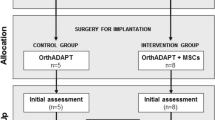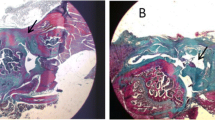Abstract
The high incidence of recurrent tendon tears after repair of massive cuff lesions is prompting the research of materials aimed at mechanically or biologically reinforcing the tendon. Among the materials studied upto now, the extracellular matrix (ECM) scaffolds of human origin have proved to be the safest and most efficient, but the current laws about grafts and transplants preclude their use in Europe. In order to overcome this condition in 2006, we started a project regarding the production of an ECM scaffold of human origin which could be implanted in Europe too. In 2009, the clinical study began with the implantation of dermal matrix scaffolds in 7 middle-aged patients affected with large/massive cuff lesions and tendon degeneration. Out of 5 cases, followed for at least 1 year in which the scaffold was employed as an augmentation device, there were 3 patients with complete healing, 1 partial re-tear, and 1 total recurrence. The absence of adverse inflammatory or septic complications allows to continue this line of research with a prospective controlled study in order to define the real advantages and correct indications offered by scaffold application.





Similar content being viewed by others
References
Burkhart SS, Athanasiou KA, Wirth MA (1996) Margin convergence: a method of reducing strain in massive rotator cuff tears. Arthroscopy 12(3):335–338
Baleani M, Schrader S, Veronesi CA, Rotini R, Giardino R, Toni A (2003) Surgical repair of the rotator cuff: a biomechanical evaluation of different tendon grasping and bone suture fixation techniques. Clin Biomech (Bristol, Avon) 18(8):721–729
Ma CB, MacGillivray JD, Clabeaux J, Lee S, Otis JC (2004) Biomechanical evaluation of arthroscopic rotator cuff stitches. J Bone Joint Surg Am 86-A(6):1211–1216
Bungaro P, Rotini R, Traina F, Baleani M, Antonioli D, Fini M, Castagna A (2005) Comparative and experimental study on different tendinous grasping techniques in rotator cuff repair: a new reinforced stitch. Chir Organi Mov 90(2):113–119
Baleani M, Ohman C, Guandalini L, Rotini R, Giavaresi G, Traina F, Viceconti M (2006) Comparative study of different tendon grasping techniques for arthroscopic repair of the rotator cuff. Clin Biomech (Bristol, Avon) 21(8):799–803
Sugaya H, Maeda K, Matsuki K, Moriishi J (2005) Functional and structural outcome after arthroscopic full-thickness rotator cuff repair: single-row versus dual-row fixation. Arthroscopy 21(11):1307–1316
Park MC, Elattrache NS, Ahmad CS, Tibone JE (2006) “Transosseous-equivalent” rotator cuff repair technique. Arthroscopy 22(12):1360e1–e5
Audenaert E, Van Nuffel J, Schepens A, Verhelst M, Verdonk R (2006) Reconstruction of massive rotator cuff lesions with a synthetic interposition graft: a prospective study of 41 patients. Knee Surg Sports Traumatol Arthrosc 14(4):360–364
Hirooka A, Yoneda M, Wakaitani S, Isaka Y, Hayashida K, Fukushima S, Okamura K (2002) Augmentation with a Gore-Tex patch for repair of large rotator cuff tears that cannot be sutured. J Orthop Sci 7(4):451–456
Heikel HV (1968) Rupture of the rotator cuff of the shoulder. experiences of surgical treatment. Acta Orthop Scand 39(4):477–492
Neviaser JS (1971) Ruptures of the rotator cuff of the shoulder. new concepts in the diagnosis and operative treatment of chronic ruptures. Arch Surg 102(5):483–485
Rhee YG, Cho NS, Lim CT, Yi JW, Vishvanathan T (2008) Bridging the gap in immobile massive rotator cuff tears: augmentation using the tenotomized biceps. Am J Sports Med 36(8):1511–1518
Cho NS, Yi JW, Rhee YG (2009) Arthroscopic biceps augmentation for avoiding undue tension in repair of massive rotator cuff tears. Arthroscopy 25(2):183–191
Neviaser JS, Neviaser RJ, Neviaser TJ (1978) The repair of chronic massive ruptures of the rotator cuff of the shoulder by use of a freeze-dried rotator cuff. J Bone Joint Surg Am 60(5):681–684
Nasca RJ (1988) The use of freeze-dried allografts in the management of global rotator cuff tears. Clin Orthop Relat Res (228):218–226
Moore DR, Cain EL, Schwartz ML, Clancy WG Jr (2006) Allograft reconstruction for massive, irreparable rotator cuff tears. Am J Sports Med 34(3):392–396
Sclamberg SG, Tibone JE, Itamura JM, Kasraeian S (2004) Six-month magnetic resonance imaging follow-up of large and massive rotator cuff repairs reinforced with porcine small intestinal submucosa. J Shoulder Elbow Surg 13(5):538–541
Iannotti JP, Codsi MJ, Kwon YW, Derwin K, Ciccone J, Brems JJ (2006) Porcine small intestine submucosa augmentation of surgical repair of chronic two-tendon rotator cuff tears. a randomized, controlled trial. J Bone Joint Surg Am 88(6):1238–1244
Malcarney HL, Bonar F, Murrell GA (2005) Early inflammatory reaction fter rotator cuff repair with a porcine small intestine submucosal implant: a report of 4 cases. Am J Sports Med 33:907–911
Zheng MH, Chen J, Kirilak Y, Willers C, Xu J, Wood D (2005) Porcine small intestine submucosa (SIS) is not an acellular collagenous matrix and contains porcine DNA: possible implications in human implantation. J Biomed Mater Res B Appl Biomater 73(1):61–67
Gilbert TW, Freund JM, Badylak SF (2009) Quantification of DNA in biologic scaffold materials. J Surg Res 152(1):135–139
Fini M, Torricelli P, Giavaresi G, Rotini R, Castagna A, Giardino R (2007) In vitro study comparing two collageneous membranes in view of their clinical application for rotator cuff tendon regeneration. J Orthop Res 25(1):98–107
Barber FA, Herbert MA, Boothby MH (2008) Ultimate tensile failure loads of a human dermal allograft rotator cuff augmentation. Arthroscopy 24(1):20–24
Adams JE, Zobitz ME, Reach JS Jr, An KN, Steinmann SP (2006) Rotator cuff repair using an acellular dermal matrix graft: an in vivo study in a canine model. Arthroscopy 22(7):700–709
Ide J, Kikukawa K, Hirose J, Iyama K, Sakamoto H, Mizuta H (2009) Reconstruction of large rotator-cuff tears with acellular dermal matrix grafts in rats. J Shoulder Elbow Surg 18(2):288–295
Burkhead W, Schiffern S, Krishnan S (2007) Use of graft jacket as an augmentation for massive rotator cuff tears. Semin Arthro 18:11–18
Dopirak R, Bond J, Snyder S (2007) Arthroscopic total rotator cuff replacement with an acellular human dermal allograft matrix. Int J shoulder Surg 1:7–15
Bond JL, Dopirak RM, Higgins J, Burns J, Snyder SJ (2008) Arthroscopic replacement of massive, irreparable rotator cuff tears using a GraftJacket allograft: technique and preliminary results. Arthroscopy 24(4):403–409
Wong I, Burns J, Snyder S (2010) Arthroscopic GraftJacket repair of rotator cuff tears. J Shoulder Elbow Surg 19(2 Suppl):104–109
Snyder SJ, Arnoczky SP, Bond JL, Dopirak R (2009) Histologic evaluation of a biopsy specimen obtained 3 months after rotator cuff augmentation with GraftJacket matrix. Arthroscopy 25(3):329–333
Rotini R, Fini M, Giavaresi G, Marinelli A, Guerra E, Antonioli D, Castagna A, Giardino R (2008) New perspectives in rotator cuff tendon regeneration: review of tissue engineered therapies. Chir Organi Mov 91(2):87–92
Funakoshi T, Majima T, Iwasaki N, Suenaga N, Sawaguchi N, Shimode K, Minami A, Harada K, Nishimura S (2005) Application of tissue engineering techniques for rotator cuff regeneration using a chitosan-based hyaluronan hybrid fiber scaffold. Am J Sports Med 33(8):1193–1201
Conflict of interest
The authors declare that they have no conflict of interest related to the publication of this manuscript. The authors FM and BE are among the inventors of the patent on the decellularization method that was applied on the human dermis.
Author information
Authors and Affiliations
Corresponding author
Rights and permissions
About this article
Cite this article
Rotini, R., Marinelli, A., Guerra, E. et al. Human dermal matrix scaffold augmentation for large and massive rotator cuff repairs: preliminary clinical and MRI results at 1-year follow-up. Musculoskelet Surg 95 (Suppl 1), 13–23 (2011). https://doi.org/10.1007/s12306-011-0141-8
Published:
Issue Date:
DOI: https://doi.org/10.1007/s12306-011-0141-8




